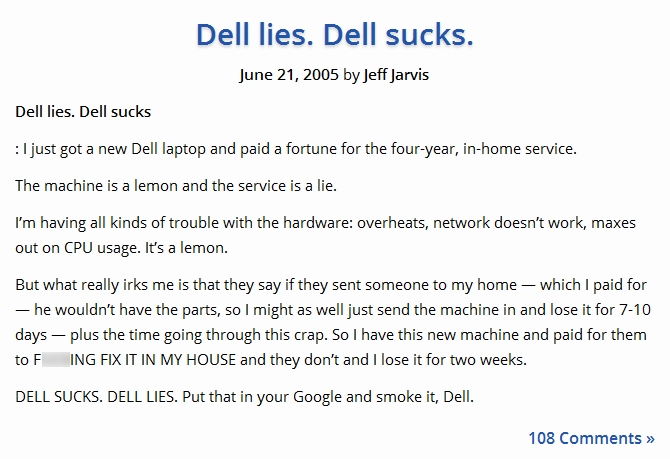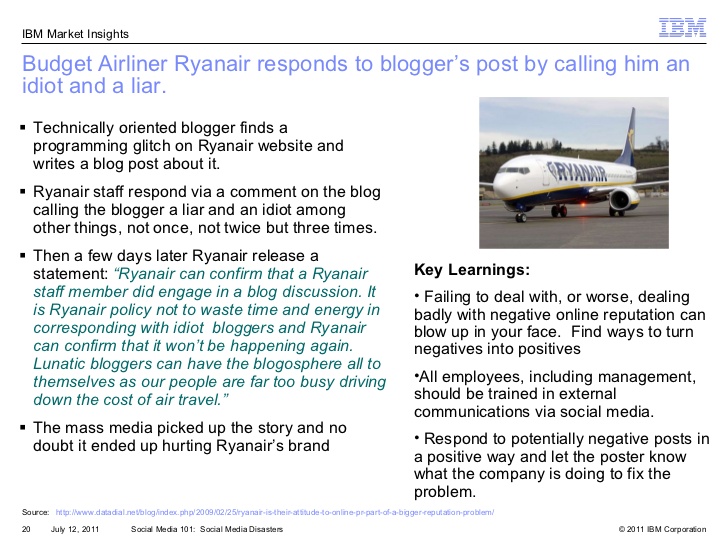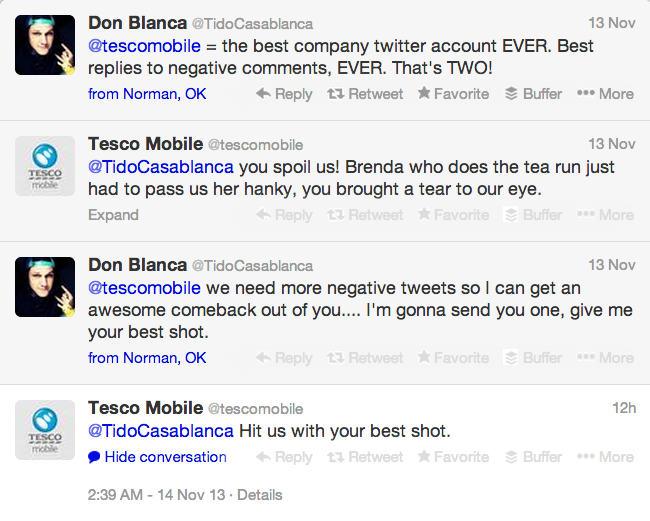Social media interaction isn’t always going to be positive. This shouldn’t be too surprising – people often use social media as an outlet to vent. This means that if a consumer takes issue with one of your products or services, they may take this up on your social media business page in public. This might seem disastrous; after all, a negative comment is going to reflect badly on your company. However, if you go about it in the right way, a negative comment can actually be turned into an opportunity that could benefit your company instead.
[Tweet “Handled properly, negative comments could actually benefit your business.”]
Why People Leave Negative Comments

Just unhappy people sharing unhappy thoughts.
You can usually tell by the tone of comment as well as its level of negativity what the reason is. However, don’t jump to conclusions – engage with the person in order to get a clearer understanding of why they left that negative comment. The following are some of the reasons why people will leave negative comments:
- They care about the brand – Loyal customers will often leave negative comments if they run into a situation that is atypical for your brand. They are complaining because they use your brand and care about its quality.
- They want to stay with your brand – More often than not, they are posting a negative comment about their experience in the hopes that you will fix the problem. If they didn’t, many of them wouldn’t bother to post the negative comments, they would just cut their losses and seek out a competitor instead. They are in essence looking for a reason to stay.
- They are looking to provoke you – Some people just want to provoke others and will use public outlets such as social media to do so. They want to give your business a bad reputation, and by eliciting a poor response to their negative comments, they will do so. These kind of people are known as “trolls” because this is what they spend their time doing online.
Whatever the reason is behind the negative comment, the last thing you want to do is respond negatively to that comment. Social media acts as an online customer service. Would you handle a negative phone call in a negative manner? If someone came into your store to complain, would you respond negatively? Of course not.
[Tweet “Only people who care about your business will bother to leave a comment.”]
What To Avoid When Handling Negative Comments

Restraining your almighty right hook definitely tops the list.
Losing your temper and responding to negative comments in a negative manner is obviously not a good idea. But there are a few other things that you should avoid doing when handling negative comments.
- Ignoring the comment – Don’t just ignore the comment and hope that it will go away. Your audience will see that the person who made the comment isn’t being responded to and this will reflect poorly on your customer service. Additionally, never delete the comment. Once it’s made, it’s there forever – people can easily bring it back up as well as the fact that you deleted it, which won’t look good on your end.
- Being dishonest – Never be dishonest. You could just call out the person who made the comment as being a liar, but if their claim is true then proof of that claim will eventually surface. This will severely damage your reputation, not to mention hurt your brand loyalty and brand trust.
The following are a few examples of well known brands that failed to handle negative comments in the proper ways:
- Dell – Back in 2005, a blogger wrote a rant about Dell products entitled “Dell Sucks. Dell Lies.” Unfortunately for Dell, readers began leaving comments dealing with their own issues with Dell. It basically became a chain of negative comments. How did Dell handle this? By trying to ignore it. It didn’t work. The blog post went viral by the time Dell finally addressed the writer of the blog, offering him a new computer and a full refund.

Dell listens. But it might be a tad too late.
- Ryanair – This budget airline made a huge mistake by responding to a blog post in a negative manner. A blogger wrote about his attempt to book a flight for free due to a bug in Ryanair’s online booking system. He criticized them for his inability to take advantage of their mistake, but then realized his own mistake and admitted it on his blog. However, Ryanair took the low road and publicly insulted him, calling him both an “idiot” and a “liar.” This is not what you want to do with your online customer service. Even though Ryanair may not have done anything wrong initially, their reaction severely hurt their reputation.

Ignoring your customers is one thing. Actively pissing them off on the other hand..
[Tweet “On the internet, ignoring or even deleting a feedback won’t make it disappear.”]
What To Do When Handling Negative Comments

Why dodge bullets when you can stop them?
So now that you know what to avoid when handling negative comments, what should you actually do? The following are eight online customer service steps you should take to handle any negative comments:
- Don’t lose your temper – Remember that your response is a reflection of your brand. You need to keep your temper and not take anything personal. This can sometimes be difficult if the person who made the comment is just attempting to provoke you into responding negatively, but your audience’s respect for you will grow if they see that you are able to handle such negative comments in a professional and calm manner.
- Apologize – Always apologize to the person who made the comment even if you aren’t in the wrong. You are apologizing for the fact that they have had an unpleasant experience and that they believe that they had to make a negative comment. A sincere apology shows that you care.
- Take it offline – After you’ve apologized, attempt to take it offline by requesting contact information from the person. This way you show that you are personally invested in the person’s problem and aren’t just making a show of it because it’s in a public space – but it also shows your audience that you are genuinely concerned with solving the issue at hand.
- Offer to solve the problem – Always make it clear that you want to solve the problem that the person has. This way if the complaint is legitimate, the person can be comfortable in the knowledge that you are working with them and not against them.
- Request information – Ask for detailed information about the problem that the person had so that you can investigate the issue. Tell the person you will get back to them after you’ve investigated the issue.
- Investigate – Make sure to figure out what is wrong and to fix it in order to prevent any future issues from re-occurring. If the complaint isn’t legitimate, then you can be safe in knowledge that the problem won’t plague other customers.
- Get back to the customer – Get back in contact with the customer and tell them your findings. Do what you can to make things right, such as by offering a refund or a free product or service.
- Follow up – Follow up on that customer after a while to see if they have had any other issues. This shows them that you truly care about your customer experiences.
[Tweet “A calm and systematic approach works best in handling negative comments.”]
Negative Comment Success Stories
The following are a few examples of well known brands that were able to successfully handle negative comments that in turn helped improve their reputation:
- Groupon – Groupon often posts deal-of-the-day items on its Facebook page and one day, it provided a link to a Banana Bunker item, which is a plastic casing to keep your bananas fresh. Their page was immediately flooded with jokes (mostly sexual in nature) – in fact, there were roughly 12,000 comments made! This could have been incredibly embarrassing had Groupon not handled it the right way. Groupon could have easily deleted them but instead, they responded to almost every comment in the most serious manner they could while being completely in on the joke. This way, they were active participants in the joke without actually making any jokes that could be deemed inappropriate. They ended up selling 1,700 Banana Bunkers and quickly ran out of stock because of the positive exposure they received.

Great save by Groupon.
- Tesco – Tesco puts a lot of effort into using its Twitter handle as a way to provide excellent customer care. They are incredibly helpful in addressing complaints and hilarious to boot! Definitely a great case study on how to follow the eight steps on handling negative comments. How successful have they been? They have tweeted more than 871,000 times since it created a Twitter profile and have increased their followers from 30,000 in January 2013 to 292,000 as of April 2015.

As well as gaining notoriety as the Twitter master of comebacks.
[Tweet “A lot can be learned from Tesco and Groupon from the way how they handle negative comments online.”]
The Benefits of Handling Negative Comments Correctly

Happy customer = happy business.
You know why not handling negative comments properly can hurt your company’s reputation, but how exactly can handling negative comments in the right way help?
- Customer loyalty – By doing everything you can to solve a person’s problem, you ensure their loyalty. People like to be taken care of and paid attention to, after all.
- Earn respect – Not only do you earn the respect of the person who made the comment for going above and beyond to try and help them, you earn the respect of other consumers that have viewed the interaction online.
- Obtain useful feedback – Negative comments often provide valuable feedback – after all, sometimes negative comments point out flaws in your company. Flaws you can fix.
- Encourage communication – If you engage with people making negative comments, you’re indirectly encouraging everyone to engage with you. You are showing your customers that you want to your products and services to be the best they can be and that you welcome the feedback.
Your online customer service is a vital part to your social media marketing strategy. Handling negative comments in the right way will help to improve the reputation of your online customer service – handle them the wrong way and you can damage your brand’s reputation as well as hurt brand loyalty and trust. But the most important part however, is the mindset of looking at crisis not as a threat, but an opportunity.
[Tweet “The mindset of finding opportunity amidst crisis extends beyond just handling negative comments.”]
[This blog post was originally written and published by Azfar Hisham on May 5, 2015. It is most recently updated by Winnie Wong on Jun 02, 2020]
Updated: 10 July 2025
Winnie is an aspiring copywriter & internet marketer in the vast world of digital marketing. She's as curious as she can be; constantly hunting for answers to her questions, never saying no to new experiences. When she's not spending her time typing up a storm, she is at home keeping up with her never-ending movie marathon & books.




























